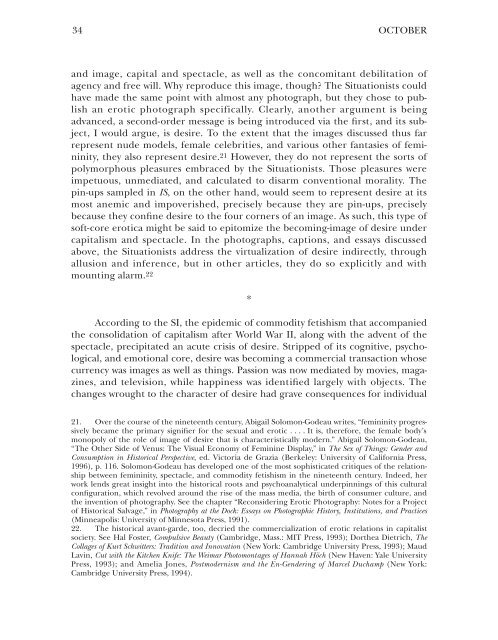The Sex of the Situationist International* - 1000 Little Hammers
The Sex of the Situationist International* - 1000 Little Hammers
The Sex of the Situationist International* - 1000 Little Hammers
Create successful ePaper yourself
Turn your PDF publications into a flip-book with our unique Google optimized e-Paper software.
34<br />
and image, capital and spectacle, as well as <strong>the</strong> concomitant debilitation <strong>of</strong><br />
agency and free will. Why reproduce this image, though? <strong>The</strong> <strong>Situationist</strong>s could<br />
have made <strong>the</strong> same point with almost any photograph, but <strong>the</strong>y chose to publish<br />
an erotic photograph specifically. Clearly, ano<strong>the</strong>r argument is being<br />
advanced, a second-order message is being introduced via <strong>the</strong> first, and its subject,<br />
I would argue, is desire. To <strong>the</strong> extent that <strong>the</strong> images discussed thus far<br />
represent nude models, female celebrities, and various o<strong>the</strong>r fantasies <strong>of</strong> femininity,<br />
<strong>the</strong>y also represent desire. 21 However, <strong>the</strong>y do not represent <strong>the</strong> sorts <strong>of</strong><br />
polymorphous pleasures embraced by <strong>the</strong> <strong>Situationist</strong>s. Those pleasures were<br />
impetuous, unmediated, and calculated to disarm conventional morality. <strong>The</strong><br />
pin-ups sampled in IS, on <strong>the</strong> o<strong>the</strong>r hand, would seem to represent desire at its<br />
most anemic and impoverished, precisely because <strong>the</strong>y are pin-ups, precisely<br />
because <strong>the</strong>y confine desire to <strong>the</strong> four corners <strong>of</strong> an image. As such, this type <strong>of</strong><br />
s<strong>of</strong>t-core erotica might be said to epitomize <strong>the</strong> becoming-image <strong>of</strong> desire under<br />
capitalism and spectacle. In <strong>the</strong> photographs, captions, and essays discussed<br />
above, <strong>the</strong> <strong>Situationist</strong>s address <strong>the</strong> virtualization <strong>of</strong> desire indirectly, through<br />
allusion and inference, but in o<strong>the</strong>r articles, <strong>the</strong>y do so explicitly and with<br />
mounting alarm. 22<br />
*<br />
OCTOBER<br />
According to <strong>the</strong> SI, <strong>the</strong> epidemic <strong>of</strong> commodity fetishism that accompanied<br />
<strong>the</strong> consolidation <strong>of</strong> capitalism after World War II, along with <strong>the</strong> advent <strong>of</strong> <strong>the</strong><br />
spectacle, precipitated an acute crisis <strong>of</strong> desire. Stripped <strong>of</strong> its cognitive, psychological,<br />
and emotional core, desire was becoming a commercial transaction whose<br />
currency was images as well as things. Passion was now mediated by movies, magazines,<br />
and television, while happiness was identified largely with objects. <strong>The</strong><br />
changes wrought to <strong>the</strong> character <strong>of</strong> desire had grave consequences for individual<br />
21. Over <strong>the</strong> course <strong>of</strong> <strong>the</strong> nineteenth century, Abigail Solomon-Godeau writes, “femininity progressively<br />
became <strong>the</strong> primary signifier for <strong>the</strong> sexual and erotic . . . . It is, <strong>the</strong>refore, <strong>the</strong> female body’s<br />
monopoly <strong>of</strong> <strong>the</strong> role <strong>of</strong> image <strong>of</strong> desire that is characteristically modern.” Abigail Solomon-Godeau,<br />
“<strong>The</strong> O<strong>the</strong>r Side <strong>of</strong> Venus: <strong>The</strong> Visual Economy <strong>of</strong> Feminine Display,” in <strong>The</strong> <strong>Sex</strong> <strong>of</strong> Things: Gender and<br />
Consumption in Historical Perspective, ed. Victoria de Grazia (Berkeley: University <strong>of</strong> California Press,<br />
1996), p. 116. Solomon-Godeau has developed one <strong>of</strong> <strong>the</strong> most sophisticated critiques <strong>of</strong> <strong>the</strong> relationship<br />
between femininity, spectacle, and commodity fetishism in <strong>the</strong> nineteenth century. Indeed, her<br />
work lends great insight into <strong>the</strong> historical roots and psychoanalytical underpinnings <strong>of</strong> this cultural<br />
configuration, which revolved around <strong>the</strong> rise <strong>of</strong> <strong>the</strong> mass media, <strong>the</strong> birth <strong>of</strong> consumer culture, and<br />
<strong>the</strong> invention <strong>of</strong> photography. See <strong>the</strong> chapter “Reconsidering Erotic Photography: Notes for a Project<br />
<strong>of</strong> Historical Salvage,” in Photography at <strong>the</strong> Dock: Essays on Photographic History, Institutions, and Practices<br />
(Minneapolis: University <strong>of</strong> Minnesota Press, 1991).<br />
22. <strong>The</strong> historical avant-garde, too, decried <strong>the</strong> commercialization <strong>of</strong> erotic relations in capitalist<br />
society. See Hal Foster, Compulsive Beauty (Cambridge, Mass.: MIT Press, 1993); Dor<strong>the</strong>a Dietrich, <strong>The</strong><br />
Collages <strong>of</strong> Kurt Schwitters: Tradition and Innovation (New York: Cambridge University Press, 1993); Maud<br />
Lavin, Cut with <strong>the</strong> Kitchen Knife: <strong>The</strong> Weimar Photomontages <strong>of</strong> Hannah Höch (New Haven: Yale University<br />
Press, 1993); and Amelia Jones, Postmodernism and <strong>the</strong> En-Gendering <strong>of</strong> Marcel Duchamp (New York:<br />
Cambridge University Press, 1994).



